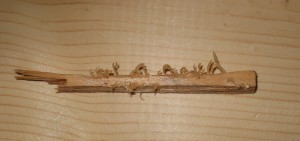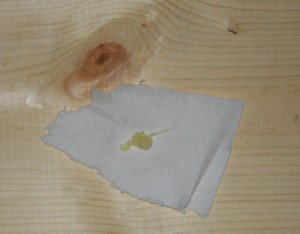I want to tie up a few loose ends here. The first one is the subject of fatwood. As I mentioned in an earlier post, fatwood is pine wood, usually from a stump, that is saturated with pine resin. I bought a box from a local ranch supply store (Murdoch’s) for about $4. It is marketed as a firestarter for fireplaces, wood stoves, and similar applications. The one I bought is marketed by fatwood.com. Walmart sells the Duraflame equivalent, although the box they sell is quite a bit larger – more than I wanted.
You can purchase small pieces of fatwood in a metal tin that are specifically for camping and emergency fires, but it’s easy to buy the $4 box and split the pieces to make enough emergency tinder for you and all your friends, and probably all their friends.
Probably the best way to light a fatwood tinder stick with a ferrorcerium rod is to make a “feather stick”, as shown below. I broke one of the sticks from the box in half and then carefully shaved “feathers” of wood so that they curled up and made a kind of “fuzzy” stick.
You can do the same thing with any wood that you want to light, but it works really well with fatwood because the resin lets the sticks catch fire easier. If you try this with a sliver from a 2×4 or some random stick you pick up off the ground, the feathers will tend to smolder rather than catch fire. You can light a feather stick from about any piece of dry wood, but it’s a lot easier if the wood is fatwood.
You can also shave the feathers off and make a little pile of them. But leaving them attached to the fatwood will keep them in place if it’s windy. If you are carrying really small pieces of fatwood (or if you carve them out of a tree in an emergency) it may not be practical to make the feather stick; just shave tiny pieces off, make a small pile, and light them.
I’ve also lit fatwood by just breaking a piece in half and lighting the exposed, ragged end. It takes a little work, but it’s possible to do. Of course, you can also light fatwood with a match or a lighter.
You can also use larger feather sticks to light with a match or lighter. But unless you’ve got a pile of large logs and no smaller tinder (very unlikely) it’s probably more work than it’s worth most of the time. In most cases, if you have a knife to make the feather stick, it would be easier to just split some kindling-sized pieces off the larger pieces.
In the post on emergency tinder, I mentioned using lip balm as a fuel to extend the burn time of a piece of cloth or tissue. Here is a picture of a little Carmex squeezed from a tube onto a piece of a tissue. I worked the Carmex into the tissue and then lit one edge with a ferrocerium rod. This amount of Carmex burned about a minute and a half.
A blob of Purell Advanced hand sanitizer about the size of a quarter also burned for about a minute and a half. Of course, one advantage of hand sanitizer is that you can smear it on the wood you are trying to light.
A single alcohol hand sanitizer sterile wipe burned for less than 30 seconds. You would want to use this with some other tinder like dry grass, dry leaves, or dry pine needles. You could also use it to light a tiny pile of very small wood slivers, which could then light a more reasonable-sized kindling pile.
That’s it, I don’t have any more to say about lighting fires. Post comments if you have suggestions.

